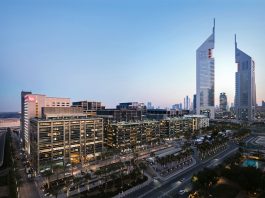Commercial
The report indicates that the lifting of trade sanctions on Iran could boost the UAE’s economic activity. Prior to the introduction of the sanctions, Iran was the UAE’s biggest trading partners, while in the past both local and global businesses hubbed any Iranian operations out of Dubai.
Morgan continued: “We have already noted an upturn in speculative requirements from Dubai-based Iranian businesses looking to expand their premises in anticipation of a resumption in normal trade with Iran. Furthermore, we have also already noted several instances of Iranian businesses in the emirate approaching banks for loans to fund planned expansion”.
In addition, Cluttons anticipates an upturn in international businesses looking to service any Iranian operations out of Dubai, which will once again place upward pressure on Grade A rents in sought after submarkets, particularly the city’s primary free zones such as the DIFC, the Internet and Media Cities, D3 and Dubai Airport Free Zone.
During the first six month of 2015, headline office space for primary, secondary and tertiary space was unchanged at AED 250 psf, AED 130 psf and AED 70 psf, respectively. This does however mask a more complex picture at a submarket level across the city. And there are exceptions to average rates, with Emirates Towers and core DIF space for instance recently quoting between AED 275 psf and AED 300 psf.
Cluttons latest research also shows that in Abu Dhabi the office market’s recent stagnation is in large part linked to the slowdown in public spending, which has translated into a drop in demand for new office space.
Durrani explained, “However, due to a general lack of supply, particularly at the Grade A end of the market, rents have held steady and are expected to remain stable over the course of 2015, with occupancy levels close to 100%. Prime rents, which stand at AED 1,850 psm, have remained stable for an extraordinary 14 quarters and super-prime buildings such as the newly established Abu Dhabi Global Market Square on Al Maryah Island continues to cement its position as the city’s ‘ultra-prime’ office benchmark with rents standing at approximately AED 3,700 psm, which is catering to a niche market of occupiers who need to be in Abu Dhabi.
“Abu Dhabi’s dependence on hydrocarbon revenues has meant that the rate of office take up, which is traditionally dominated by oil and gas companies has cooled significantly. This is likely to put increased downward pressure on more secondary and tertiary locations in the first instance, with prime rents likely to face headwinds at the beginning of 2016.”
For Sharjah, office rents in the main submarkets held steady during the second quarter, following no change in Q1. The flat performance of the office market reflects a scaling back in overall requirements and take up levels while the dominant oil and gas occupiers assess their expansion plans. The ability of the market to weather the continued low oil price environment, or weakening demand, is expected to put rents under pressure, particularly at the top of the market.
Morgan concluded: “In more secondary and tertiary locations landlords are adjusting rents downwards in an effort to generate demand. This widening gap between the two tiers of the market is unlikely to be sustainable, with Grade A rents likely to slip later on in the year. Overall, rent declines of up to 5% are likely across the board before the end of the year.”












![The Square at Nad Al Sheba Gardens Now Open hope tax season treated you well! Just checking in—ready to refocus on growing your business? I remember how we discussed scaling your [specific aspect of their business, e.g., online presence] but paused due to time constraints. We now offer a streamlined 6-month plan that delivers real results without adding to your workload. Let me know if you'd like to chat—I’d love to help you pick up where we left off!](https://www.dubaichronicle.com/wp-content/uploads/2024/11/The-Square-5-265x198.jpg)